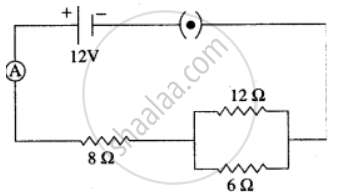Advertisements
Advertisements
Question
What do you understand by the term "potential difference"?
Solution
The potential difference between two points in an electric circuit is equal to the amount of work done in moving a unit charge from one point to another point.
`"Potential difference(V)"="Work done (W)"/"Quntity of charge moved (Q)"`
APPEARS IN
RELATED QUESTIONS
What is meant by saying that the electric potential at a point is 1 volt?
State the relation between potential difference, work done and charge moved.
What is a voltmeter?
How is a voltmeter connected in the circuit to measure the potential difference between two points? Explain with the help of a diagram.
If a potential difference of 10 V causes a current of 2 A to flow for 1 minute, how much energy is transferred?
Keeping the potential difference constant, the resistance of a circuit is doubled. By how much does the current change?
The values of potential difference V applies across a resistor and the corresponding values of current I flowing in the resistor are given below:
| Potential differences, V (in volts) | : | 2.5 | 5.0 | 10.0 | 15.0 | 20.0 | 25.0 |
| Current, I (in amperes) | : | 0.1 | 0.2 | 0.4 | 0.6 | 0.8 | 1.0 |
What current will be taken by a 920 W appliance if the supply voltage is 230 V?
Explain the statement ‘the potential difference between two points is 1 volt’.
Three resistors are connected to a 12 V battery as shown in the figure given below:

(i) What is the current through the 8 ohm resistor?
(ii) What is the potential difference across the parallel combination of 6 ohm and 12 ohm resistor?
(iii) What is the current through the 6 ohm resistor?
